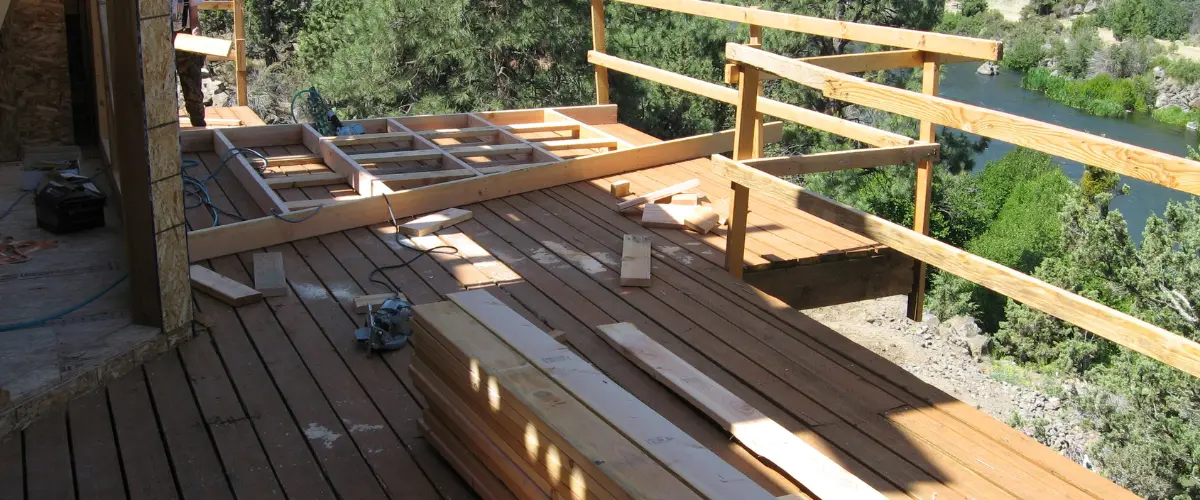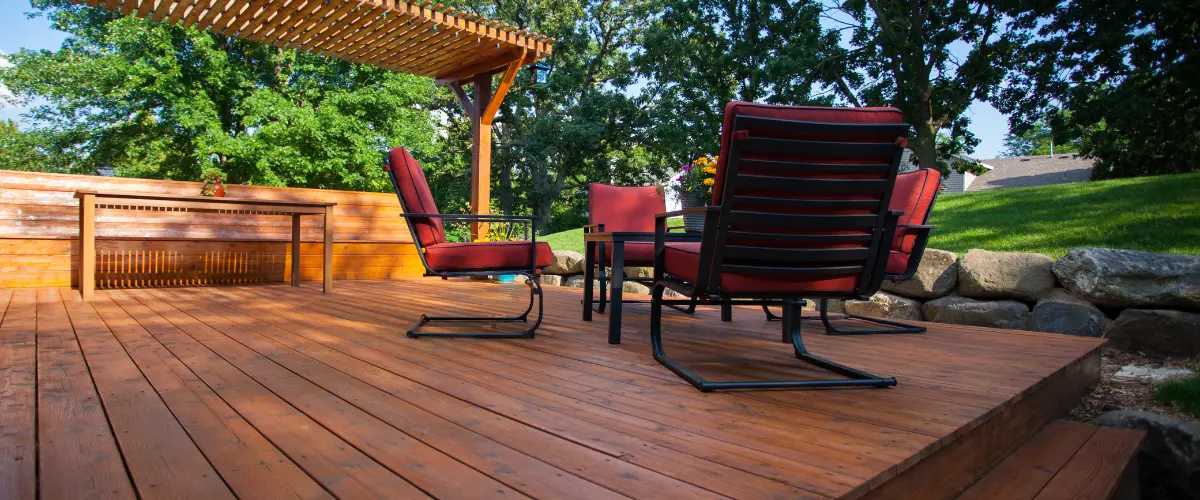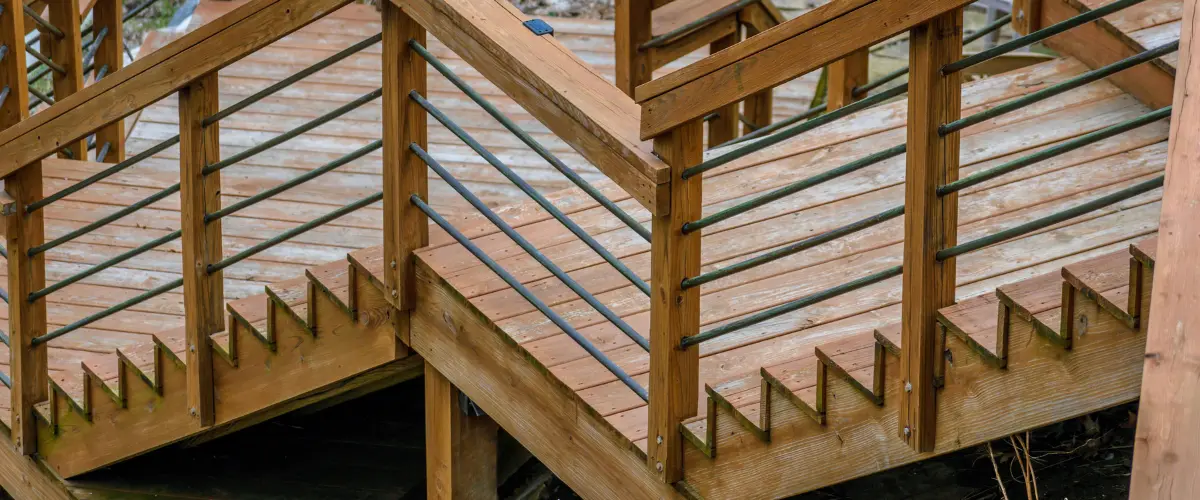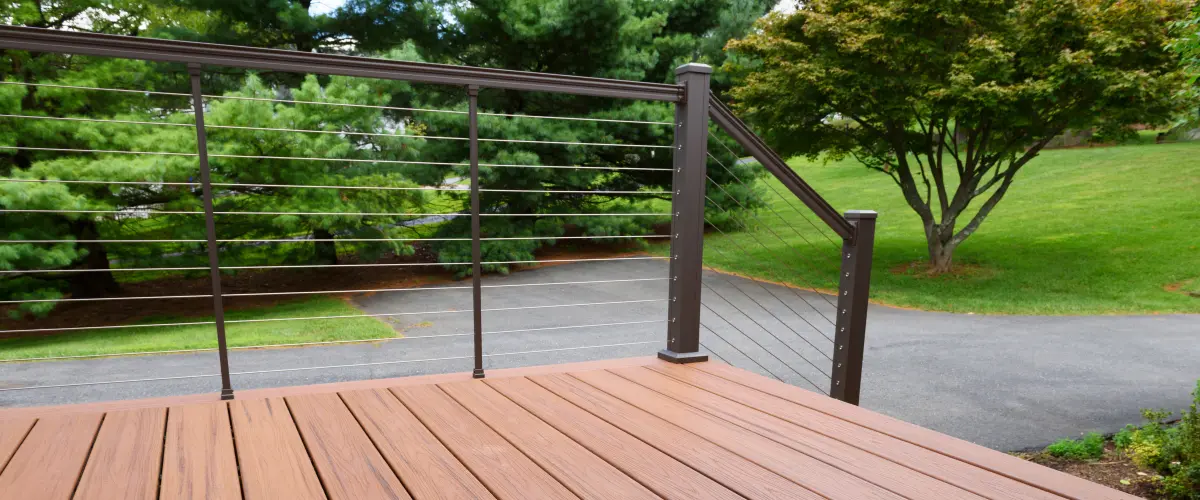Many homeowners worry their decks might fail inspection. Interestingly, regular deck inspections can prevent most issues before they become serious. Our guide offers a comprehensive checklist for inspecting your deck, ensuring its safety and prolonging its life.

Starting With The Foundation
The soil underneath your deck plays a crucial role in the overall stability and safety of your structure. If the ground is too soft or not properly compacted, it may shift over time, causing structural support issues for your deck’s frame.
Ensuring that the soil has good drainage is also key to prevent water from pooling around the footings and columns, which can lead to wood decay and compromise the deck’s foundation.
For a thorough inspection, look at how close the base plate sits to direct contact with earth; this could make it easy for moisture or insects like carpenter ants and bees to cause damage.
Regular checks can help identify any potential problems with soil erosion or instability that might require professional attention. Next on the checklist is assessing structural support.
The Importance Of Deck Inspections
Deck inspections ensure the structural integrity and safety of your deck, which supports foot traffic, gatherings, furniture, and sometimes heavy snow or rain accumulations.
Without proper inspection and maintenance, decks can suffer from wood rot, insect damage, and wear that compromise their stability.
Inspecting a deck helps identify issues like loose fasteners, sagging boards, water stains, and rust on metal parts before they lead to larger problems. Regular checks align with current safety standards and help avoid potential failures that could result in costly repairs or injuries.
Making sure that your deck is properly maintained guards against unexpected collapses and keeps it a secure place for relaxation and enjoyment for years to come.

Deck Inspection Checklist
Footings And Columns
Check the footing and columns for stability and security. The footings, usually made of concrete, should be deep enough to avoid frost heave in colder climates. Look for cracks or shifts in the footings that could weaken deck support.
Columns or support posts should stand straight and firmly attach to both the deck frame and their base supports. If they’re set directly into soil, ensure there’s no rot at the base which can compromise your deck’s safety.
Make sure all columns are properly connected to their concrete footings with a metal plate or bracket to prevent movement. Signs of rust on these connections could indicate moisture damage, which is a serious concern for long-term durability.
Regular inspections help catch these issues early, maintaining your deck’s structure and preventing costly repairs.

Soil Underneath
The soil underneath your deck plays a crucial role in the overall stability and safety of your structure. If the ground is too soft or not properly compacted, it may shift over time, causing structural support issues for your deck’s frame.
Ensuring that the soil has good drainage is also key to prevent water from pooling around the footings and columns, which can lead to wood decay and compromise the deck’s foundation.
For a thorough inspection, look at how close the base plate sits to direct contact with earth; this could make it easy for moisture or insects like carpenter ants and bees to cause damage.
Regular checks can help identify any potential problems with soil erosion or instability that might require professional attention. Next on the checklist is assessing structural support.
Structural Support
Regularly check for any signs of rot, cracks, or damage as these can weaken the overall structure.
Look out for any missing or loose connections between different components such as ledger boards and framing brackets. It is essential to maintain a strong and stable structural support system to ensure the safety and longevity of your deck.
Regular inspections of your deck’s structural support can help identify issues early on and prevent potential hazards.
Fasteners And Flashing Details
Ensure that all bolts, screws, and nails used in construction are tight, secure, and free of rust or corrosion.
Pay special attention to ledger board attachments because they can be a common source of failure if not properly installed. Flashing details around areas such as ledgers, posts, and railings play a critical role in preventing water damage by directing moisture away from vulnerable areas.
Properly installed flashing can significantly extend the life of your deck by protecting against rot and structural damage.
Inspecting fasteners is crucial for ensuring the safety and stability of your deck. Loose or corroded fasteners can compromise the integrity of the entire structure over time. Additionally, maintaining proper flashing details provides protection against potential water damage which could lead to costly repairs down the line.
Regular inspections will help identify any issues before they escalate into major problems.
Deck Attachments
Deck attachments encompass all hardware used to connect various components of the deck structure, including joist hangers, lag screws, and span braces. These components play a vital role in holding the deck together under load-bearing conditions and must be meticulously inspected during annual inspections to prevent potential hazards.
Lag screws should be checked for their tightness, while joist hangers need to be examined for signs of corrosion or damage due to weather exposure.
A professional inspector will pay close attention to these minute but critical details during a thorough examination of your deck’s condition as loose or deteriorated attachments can compromise the entire structure’s integrity over time.
Neglecting these elements may lead to issues such as nails popping out or wood splitting, posing risks that could have been prevented through proper maintenance and inspection.
Framing Brackets
Framing brackets are crucial for supporting the structural integrity of your deck. These metal brackets connect the deck’s frame to the posts and provide essential stability. As you inspect your deck, ensure that all framing brackets are securely attached and not showing signs of rust or corrosion.
Look out for any missing or damaged brackets, as they can weaken the entire structure and compromise safety. Regularly checking and maintaining these components will help prevent potential issues with your deck’s support system, ensuring a safe outdoor space for you and your family.
It is vital to have a professional inspection if you notice any issues with the framing brackets to address them promptly, keeping in mind that a secure foundation sets the stage for a safe and enjoyable outdoor living area.

The Decking
The decking, or deck surface, plays a crucial role in the safety and longevity of your deck. Regularly inspecting the wood boards for any signs of wear, decay, or insect infestation is vital to ensure that your deck remains safe and maintained properly.
Look out for white stains on the wood ends which might indicate insect damage and potential structural concerns. Checking the condition of your wooden railing and sheet metal flashing details should also be part of your routine maintenance to prevent falls and identify issues early on.
Maintaining good shape of the decking boards not only enhances the aesthetics but also underpins deck safety. It’s imperative to keep an eye on these components as they are essential elements contributing towards making sure that your deck adheres to local requirements and remains safe for use by you and your loved ones.

condition Of The Wood
Inspect the wood for signs of rot, decay, or pest infestation. Look for soft spots, holes, and sawdust around the deck boards or support posts. Check for cracks, splintering, or warping which could compromise the structural integrity of your deck.
Regularly clean and apply a protective sealant to prevent moisture damage and prolong the life of the wood decking.
Maintaining the condition of the wood is crucial in ensuring your deck’s longevity and safety. It also prevents costly repairs down the line due to structural issues stemming from neglected maintenance.

Stairs
When inspecting your deck, make sure to thoroughly check the stairs for any signs of wear or damage. Pay close attention to the stability of each step and the condition of the railing.
Look out for loose or rotting steps, as well as any wobbly handrails that could pose a safety risk. Carpinter bees can also cause damage to wooden stairs over time, so be vigilant in checking for their presence.
Consider this: Over 60% of all residential deck failures are due to a problem with the stairs or guardrails. Taking the time to inspect and maintain your deck’s stairs can prevent accidents and ensure the safety of your family and guests.

Railings
Inspect railings for any signs of damage or wear, including loose balusters and cracked wood. Check that the height meets safety code requirements, typically around 36 inches for residential decks.
Make sure there are no spaces wider than 4 inches between each railing to prevent small children from slipping through. Inspect for secure attachment points to the deck structure.
Regularly keeping an eye on your deck railings can help ensure they remain sturdy and safe for everyone who uses your outdoor space, preventing accidents and potential issues down the line.

Signs Your Deck May Need professional inspection/repair
If you notice any signs like loose or wobbly railings, cracked or warped floorboards, or visible rotting in the wood, it’s time to consider a professional deck inspection. Additionally, if you see any rusted or corroded fasteners and flashing details, these could indicate potential safety hazards that require immediate attention.
Carpenter bees nesting in the wood can also be a sign of structural weakness. Don’t ignore these indicators; they could signal significant issues that need to be addressed promptly by a professional for your safety and peace of mind.
Keep an eye out for any noticeable sagging or movement when walking on the deck. Also, check for water pooling around footings which can lead to soil erosion over time. Any unusual creaking sounds while using the stairs should not be overlooked as they might signify underlying problems with the structural support.
Identifying these warning signs early on through professional inspection and repair work can prevent more extensive damage down the line and keep your deck safe.Z
FAQs
Why Choose Our Professional Team
Our team has provided deck repair and installation services for years, embodying professionalism and expertise. There is no point in losing your money and risking your safety by choosing a team with less experience.
Ready to begin? Contact us at (402) 369-5724 to start your project with industry experts.
